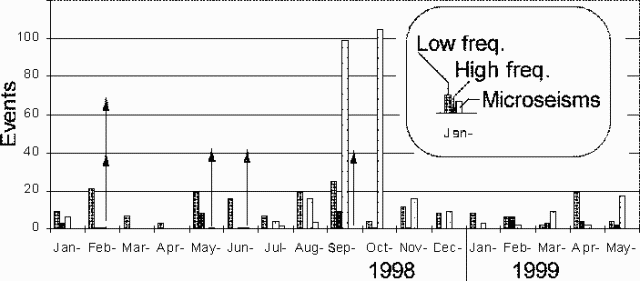Report on Rincon de la Vieja (Costa Rica) — June 1999
Bulletin of the Global Volcanism Network, vol. 24, no. 6 (June 1999)
Managing Editor: Richard Wunderman.
Rincon de la Vieja (Costa Rica) 1.5-year record of seismicity and eruptions through May 1999
Please cite this report as:
Global Volcanism Program, 1999. Report on Rincon de la Vieja (Costa Rica) (Wunderman, R., ed.). Bulletin of the Global Volcanism Network, 24:6. Smithsonian Institution. https://doi.org/10.5479/si.GVP.BGVN199906-345020
Rincon de la Vieja
Costa Rica
10.83°N, 85.324°W; summit elev. 1916 m
All times are local (unless otherwise noted)
Seismicity during 17 months through April 1999 (figure 14) showed pronounced peaks at over 100 events/month in one parameter, microseisms, during September- October 1998. Otherwise, relative quiet prevailed; microseisms, high-frequency, and low-frequency events all generally took place fewer than 20 times/month. Tremor was nearly absent during roughly half the months of 1998 and in 1999 during January, February, and April. Months with 2-10 hours of tremor included February, August, September 1998 and March and May 1999.
In March, fumarolic activity continued on the NE, S, and SW walls of the main crater. The lake had a gray color and contained suspended particles of sulfur. The temperature of the lake was 35.5°C.
During May, the main crater's N-flank fumarolic activity fluctuated in temperature between 68°C and 92°C. The lake in the crater was light blue with particles of sulfur, and a temperature of 37°C. On the S and N walls, there were columns of gases that irritated eyes and skin.
Geological Summary. Rincón de la Vieja, the largest volcano in NW Costa Rica, is a remote volcanic complex in the Guanacaste Range. The volcano consists of an elongated, arcuate NW-SE-trending ridge constructed within the 15-km-wide early Pleistocene Guachipelín caldera, whose rim is exposed on the south side. Sometimes known as the "Colossus of Guanacaste," it has an estimated volume of 130 km3 and contains at least nine major eruptive centers. Activity has migrated to the SE, where the youngest-looking craters are located. The twin cone of Santa María volcano, the highest peak of the complex, is located at the eastern end of a smaller, 5-km-wide caldera and has a 500-m-wide crater. A Plinian eruption producing the 0.25 km3 Río Blanca tephra about 3,500 years ago was the last major magmatic eruption. All subsequent eruptions, including numerous historical eruptions possibly dating back to the 16th century, have been from the prominent active crater containing a 500-m-wide acid lake located ENE of Von Seebach crater.
Information Contacts: E. Fernandez, V. Barboza, E. Duarte, R. Sáenz, E. Malavassi, M. Martinez, and R. Van der Laat, T. Marino, and E. Hernandez, Observatorio Vulcanológico y Sismológico de Costa Rica, Universidad Nacional (OVSICORI-UNA), Apartado 86-3000, Heredia, Costa Rica; Wendy Perez Fernandez, Seccion de Seismologia, Vulcanologia y Exploracion Geofisica, Escuela Centroamericana de Geologia, Universidad de Costa Rica, POB 35-2060, San José, Costa Rica.


